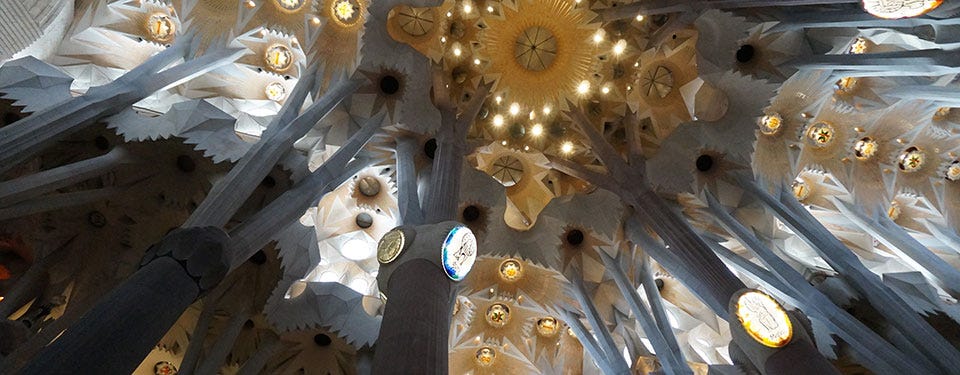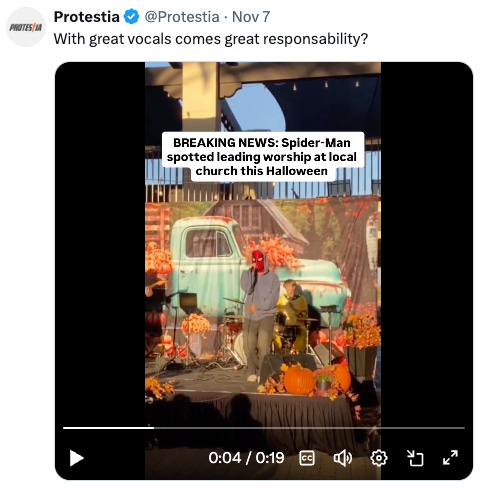Why Do We Settle for Ugliness?
When was the last time the ceiling in your church drew your eyes to heaven because it is beautifully designed?
Before you begin reading, do me a favor and share this post (or any post) with a friend or colleague. I’d love to reach 1,000 subscribers before December.
A new photo from my travel library greets me every morning when I walk into our living room. This morning, it was the ceiling of the Basilica de la Sagrada Família in Barcelona. It’s stunning; I marveled at its elegance and beauty. Antoni Gaudí designed La Sagrada Basilica to lift your eyes to heaven and to God.
When was the last time the ceiling in your church attracted your attention because of its beautiful design?
Which leads me to ask: Why do we settle for surroundings that are dull, utilitarian, and uninspiring?
In a culture intent on elevating immorality, lies, and ugliness, we need goodness, truth, and beauty more than ever. We need beauty in our homes, at work, and in the church. We need to move beyond interior decoration and be reminded that art can make us think, wonder, and transcend.
“And now, dear brothers and sisters, one final thing. Fix your thoughts on what is true, and honorable, and right, and pure, and lovely, and admirable. Think about things that are excellent and worthy of praise.” – Philippians 4:8 (New Living Translation 2nd Ed.)
A few years ago, a college friend and pastor asked for my input on how art can inspire, encourage, and challenge believers in the local church. Here’s his initial question:
“The church is in a 10-year-old metal building. Everything’s gray! I’m working on bringing some color into the building. Over the last few years, I have become much more sensitive to how art can inspire and encourage, not to speak of how art can challenge and “preach.” But in wanting to bring art — i.e., painting, sculpture, etc. — into the church, I’m at a loss about how to begin developing a plan for it or to make financial provision for it. Looking for guidance…”
One reason churches lack much art is that the Western Church largely abandoned the arts long ago, replacing artistic depth with sentimentality.
If art of any kind couldn’t be used for Sunday school or evangelism, it was considered unworthy and largely overlooked. Many churches design complex graphic and environmental themes to enhance sermon series and worship ”experiences” and call it “worship arts.” Religious theatre is no replacement for the arts in our lives—in our churches, our homes, and our spirits.
I found these books instrumental in developing a biblical mindset about art.
HR Rookmaker’s “Art Needs No Justification” (amzn.to/3JBNIhh) is an excellent treatise on how the Church (and Christians) have lowered their aesthetic standards and failed to engage with contemporary culture meaningfully, often preferring to imitate rather than be original.
Francis Schaeffer’s “Art and the Bible” (amzn.to/49thkIj) is an excellent work. One of the most important and concise works on art ever written.
Find current books on art and Christian faith at Square Halo Books. I recommend “It Was Good: Making Art to the Glory of God” (www.squarehalobooks.com/#/it-was-good-art/).
You can rent collections of visual art from my colleague and client, Sandra Bowden, via the Bowden Collection.
Follow Protestia on X to see how some congregations turn church into theatre.
Fill Your Space with Light
When I originally wrote this, my office was in a building with battleship gray beams and tinted glass. Were it not for the light, it would be thoroughly depressing.
Whether it’s a church or a business, your environment and your existing architecture can be treated as art.
Starting with color is a good place to start. It doesn’t need to, but as a metaphor, color can speak to the beauty of grace and God’s revealing work in our lives.
A central panel covered in vibrant red can be a focal point that draws the attention of the church family and visitors to the sacrifice of Christ’s blood.
Avoid kitschy references to any evangelism tools. Remember, art needs no justification.
Too many churches try to appear so polished and perfect that their environment becomes a stage for a production and an entertainment venue — a whitewashed imitation of what the Church should be. Art should be authentic, not trite. The environment in your church has the potential to be a work of spatial art. It’s architecture. If it’s metal and industrial, don’t try to hide it; accentuate it with bold color. If it’s warm woods and light, add some color.
What can you do with light, especially natural light? I am puzzled by churches that darken their worship spaces. We worship a God of light! Why do we gather in darkness? Light fosters relationships among familiar friends and visitors; it also allows us to read the Word while it is being preached.
Art is for (God’s) glory and for beauty. God told Moses that he had filled Bezalel with his Spirit to create works of art for the tabernacle. In Exodus, the art of the tabernacle was designed to enhance the place where God lived among his people.
Why not surround yourself with beauty that reminds you of God’s presence?
Bonus idea:
One simple art idea is to mount a series of circular mirrors. Choose a series of words such as Redeemed, Forgiven, and Adopted. Cut these words in frosted vinyl and mount them on the mirror. Mount the mirrors and invite people to look into the mirrors and reflect on their current — or future — identity in Christ.
If you’ve read this far, do me a favor and buy a copy of Essential: A 30-Day Devotional for Faith-Driven Professionals to give away, or join me in reading Essential and Unshakable on the Bible app.



